| 1 | Green vine snake |

The green vine snake measures 1-2 metres, and mainly inhabits rainforests and riverside gallery forests. This is a patient ambush predator, which captures reptiles running along branches and small birds such as hummingbirds. Green vine snakes are an all-powerful species, ranging from central Brazil to southern Mexico, and part of the reason for their success is looking as demented as possible. If a human walks past their branch, Oxybelis fulgidus may not react, or they may fly into an insane frenzy. The photo above shows a green vine snake preparing to unleash a strike, probably against the photographer themselves. The vine snake in this photo even has an insect on its head, like it can spew swarms of them at people.
Green vine snake venom is tailored against its lava lizard and iguana prey. It usually causes little more than swelling or pain in human beings, and must be chewed into a victim’s arm repeatedly to take effect.
That said, this snake is so demented that they may be difficult to rip away once they’ve secured a fang hold. There was one report of a 67 year old man experiencing dizziness, so there may be more substance to their demented appearance than previously believed. Several once “harmless” snakes have ended up being unexpectedly dangerous, like the western hognose snake.
| 2 | West diamondback rattlesnake |
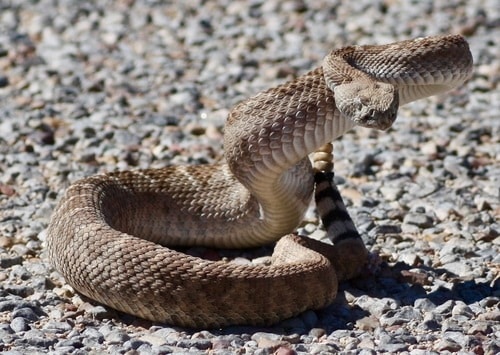
This cursed snake covers a vast swathe of the southern USA, from southern California to western Kansas. Tied with their eastern cousin, they’re responsible for the most US snakebite deaths.
West diamondbacks (Crotalus atrox) are much more likely than their neighbours to appear in backyards. Mojave rattlesnakes only appear on barren desert flats, while rock rattlesnakes stick to tumbling rock slopes in obscure desert hills. Crotalus atrox is significantly more comfortable near people. They tend to provide a warning strike first, as shown above, but vipers are unpredictable and sometimes skip warnings altogether, particularly while basking in the sun (they hate being disturbed).
Just remember that the photograph above wasn’t generated by AI, but taken by a very brave person, though whether they survived is debateable. It’s possible their camera washed into a creek following a summer downpour, and was only grabbed and processed downstream.
Luckily, west diamondbacks combine a 1.5-2 metre length (record 233.7cm) with a thick body that makes them hard to miss. They’re doubly impossible to miss if their neck is raised in mid-air and their body thrown into S-shaped coils, contorted at bizarre angles.
| 3 | Brown tree snake |
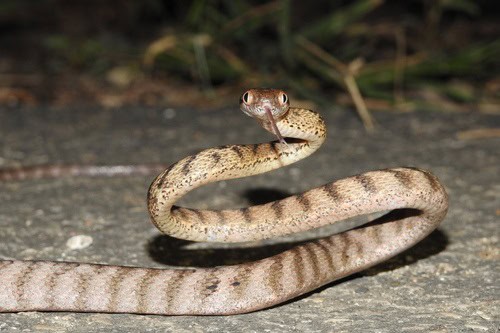
Thankfully not a deadly venomous snake, except perhaps for infants whose smaller body weight makes each drop of venom more powerful. Brown tree snakes live in northern Australia and New Guinea, but have invaded Guam and reached populations of over 2 million, and 13,000-30,000 per square mile.
The main damaging effect has been on the birds, with 10/12 forest species going extinct, resulting in a deathly silent forest, and an abundance of spider’s webs due to the lack of bird predators. But it isn’t fun for Guam locals (and US soldiers) to be stepping over snakes, creeping past them while they cling to walls, and looking up constantly to ensure that a brown tree snake isn’t falling on their heads. This island only measures 10km by 50km, and the species has infested every corner.
Brown tree snakes have no fatalities to their name, yet have a vicious personality. Invade their space and they will make vicious lunges, and snaps with their fangs, whether real or feigned.
With their bulging eyes, sticking sideways off their head like a frog, this snake has a particularly demented appearance while attacking. The photo above shows a brown tree snake readying itself for such an assault. Unlike a rattlesnake, their head is raised above their body while in their final strike posture. Their body is similarly coiled to enable a springing motion, and this can achieve great lengths, considering that brown tree snakes regularly exceed 2 metres on Guam.
| 4 | Sri Lankan pitviper |
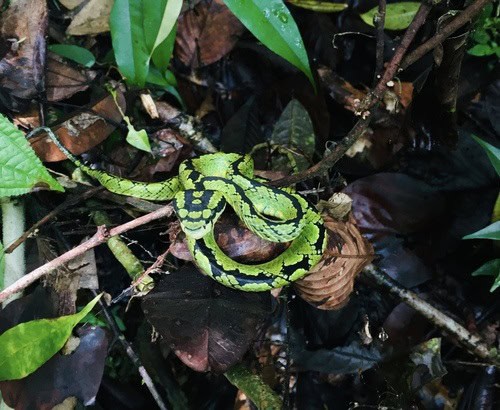
This photo is slightly less alarming, yet all the most dangerous for it. The image is a Sri Lankan pitviper, (Craspedocephalus trigonocephalus), one of the venomous species endemic to the island nation, found nowhere else on Earth. The species is relatively thin, and while trying its best to look intimidating, it can’t match the fear factor of a rattlesnake. But this is where the danger lies, because this forest dweller is much less likely to be seen, both due to its smaller size, and its blending with the juicy jungle foliage.
This pitviper is on the forest floor, and most explorers would walk right past them. In a swarming, humid, chirping, moaning, cackling jungle, it’s easy to miss one 60cm pitviper, even when they’ve already identified you as a mortal threat, and thrown themselves into an aggressive display. Perhaps you walk on and never understood how close you came, or perhaps you wait to admire a rainforest waterfall just a moment too long, and feel fangs sink into your ankle.
The image shows a typical viper posture: sudden coils of its back, neck and chest, with a particularly sharp kink around the neck, to face its predator head on. To a snake, facing your opponent head on is designed to show fearlessness, just as with humans. Many snakes that refuse to fight will hide their heads in their coils to protect their brain.
| 5 | Indian cobra |
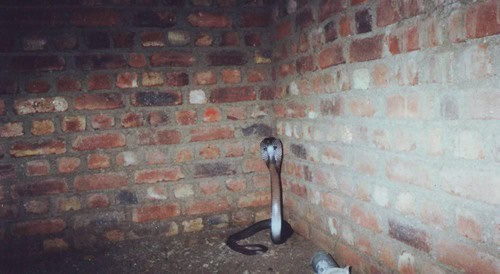
Naja naja is India’s main cobra, which inhabits virtually the entire country, excluding sand deserts. We don’t know what the story behind this picture is. Maybe smoking teenagers headed into their abandoned building hangout and found that someone else had discovered it. Maybe a travelling Indian mystic took shelter one night and woke up to find a new friend (which he may have taken as a sign).
What we do know is that the cobra is agitated, and is performing the species’ classic threat display, which often appears seconds before a lethal strike. The Indian cobra is clearly backed into a corner with nowhere to escape to. It has made the completely logical decision to attack, and has reared the upper third of its body up, with its neck vertebrae flaring outwards to create a hood.
Indian cobras provide victims with a grace period where they flare their necks, but hold off on attacking for a moment. This gives their enemies a chance to back off, as despite their lethal venom, Indian cobras would rather not engage at all. Flight is their preferred choice, but if trapped in a concrete building, that might not be possible. While the photo shows an India cobra’s classic defensive posture, there’s little difference between offense and defence for this species.
| 6 | Black-tailed rattlesnake |
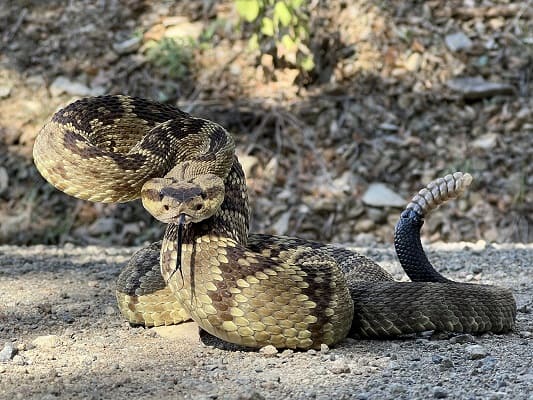
The black-tailed rattlesnake is one that few ordinary citizens encounter, but you don’t need to be a genius to run away when you see them doing this.
This is a species of Arizona and New Mexico, with a record length of 152.2cm. Like most rattlesnakes, it coils its mid-body into a semi-S shape before striking. Below its neck is typically the highest point, with its head and face kept slightly lower. At the neck itself, there’s a sharp kink so that its intimidating viper face directly faces the opponent. The purpose is to be coiled up like a spring, with maximum muscular tension, so that when they release, they lunge forward with a speed that defies a rattlesnake’s often sluggish everyday manner.
The black-tailed rattlesnake will also loll out its oily black tongue. Mother Crotalus molossus have been spotted defending their young, advancing viciously on a human near Tucson, Arizona who strayed too close to a pile of rocks where the newborns were secretly stashed.
Crotalus molossus is easy to identify, as no other US rattlesnake has such a clearly darkening tail. Great times to identify this tail are while sitting on a picnic bench, while the rattlesnake is reared up in attack posture, while it’s flying through the air majestically, and strangely getting larger and larger.
| 7 | Mount Kenya bush viper |
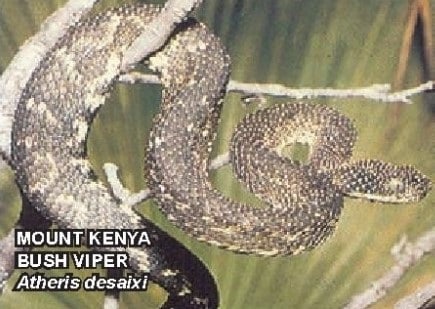
Barely anything is known about this rare, 70cm viper. Its entire purpose in life seems to be preventing tourists from ascending the slopes of its Mount Kenya, acting as a guardian in the lower forested sections, ensuring that nobody penetrates the first wall of defences. The snake in this photo is clearly doing its duty. The only known habitats of Atheris desaixi are the southeast slopes of Mount Kenya and the forested Nyambeni mountains not far away.
This photo is in typical posture for the Atheris viper family – coiled up on its tree, retracting its neck and head, with its lower body securely fastened around the branch to prevent it from plummeting to the ground during its explosive lunge. The photo above was taken by the US army, and is one of the few to exist of Atheris desaixi.
The Mount Kenya bush viper is believed to have a haemorrhagic venom, but other members of the Atheris viper are equipped with neurotoxins. Regardless, if you see one coiled like a spring such as above, you should turn around and find a new way to the summit.
| 8 | Ceylon catsnake (?) |
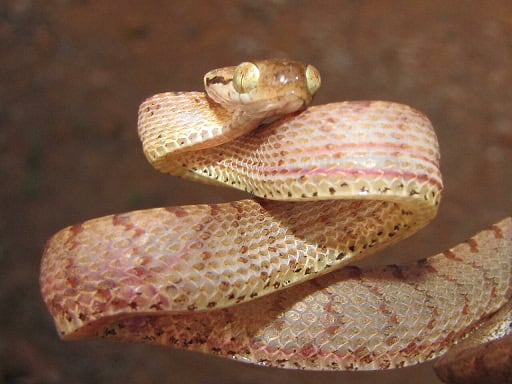
A mildly venomous species with a sharp bite, which lives exclusively on Sri Lanka. Ceylon catsnakes (Boiga ceylonensis) prey on geckos, cling to trees while regularly invading houses, and are known for their aggressive disposition.
Maybe it’s just us, but this snake is far less intimidating than its Boiga cousin, the brown tree snake. Something about its overly enormous eyes and facial expressions just don’t pass muster. It’s like the ceylon catsnake is barely convinced itself, knowing that it can’t compete with its cousin, and is just going through the motions with a sigh. Huge eyes with vertical pupils are intimidating according to nature’s rulebook, but this species tips way into cartoonish territory.
Upon closer inspection, the image is mislabelled. The photo is from Kerala, India, but as of 2024, Ceylon catsnakes are deemed to live exclusively on Sri Lanka. This catsnake is a different species, perhaps a Thackeray’s catsnake or Beddome’s catsnake.
| 9 | Radiated ratsnake |
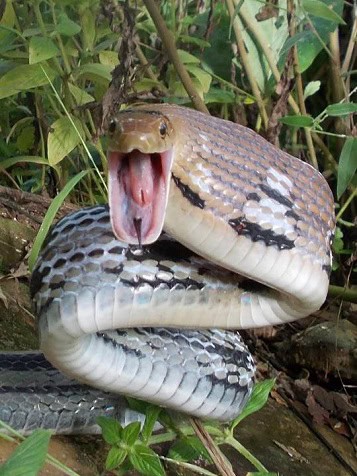
This is a much more focussed and serious-looking species than the mysterious catsnake above. In fact, the copper-headed trinket snake might have the most vicious, demented-looking strike posture of any non-venomous snake. Worse, they’re not just bluffing. Their mouth is bared wide, and yes they might bite you. They’re coiled tightly like a spring, and yes, they might unload on you, striking within milliseconds.
The copper-headed trinket snake resides in Thailand, Cambodia and Vietnam. This is a ferocious contender in general. They can blast into the undergrowth at exceptionally high speeds, disappearing the second you loosen your grip. They have vicious tearing fangs which they wield expertly, and are more than capable of drawing blood.
While Coelognathus radiatus lacks venom and cannot kill you, they mean everything they imply with their threat display. This species measures up to 210cm, and moves primarily by day. Part of their defensive repertoire is spreading their scales to reveal bright white skin underneath. Supposedly, Coelognathus radiatus is able to enlarge their neck vertically, instead of horizontally like a cobra.
| 10 | Prairie rattlesnake |
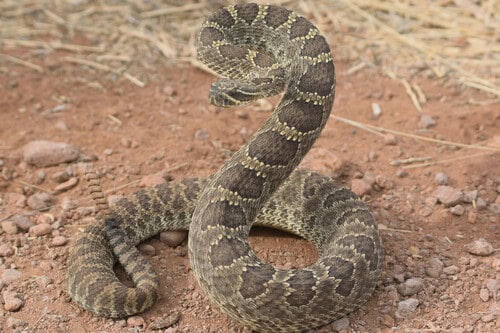
For our final photo, we return to the Crotalus rattlesnake genus. This species has two main danger factors to consider. Firstly, it lives in sweeping prairie hills amid long dry grasses, which it blends into perfectly with its camouflage, making them tricky to spot. Yet living in such open spaces also makes them easier to spot compared to if they inhabited jumbled rock fields (like the rock rattlesnake).
Prairie rattlesnakes are particularly common in Colorado, New Mexico and Wyoming, and are medium length for their family, with an all time record of 151.5cm. This species uses the classic rattlesnake threat display, with its head held lower than the upper back, and a sharp kink in the neck at the last moment.
If you see Crotalus viridis performing this action, don’t stare in wonder. Run over the prairies as far as you can. If you’re lucky, it will rattle its tail loudly before you ever get close. Throwing their body high in the air is also easier to spot compared to if they kept themselves close to the ground.
